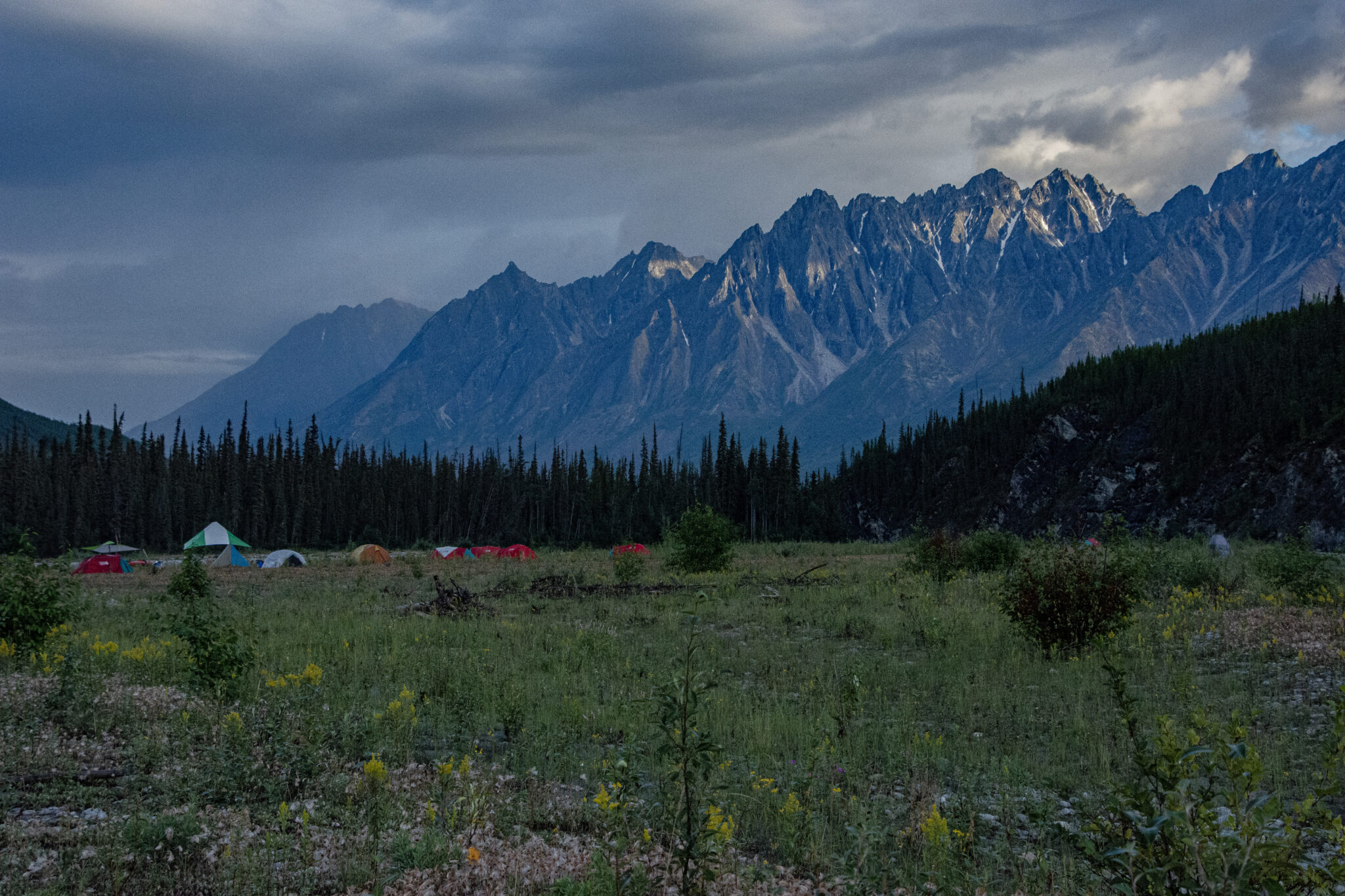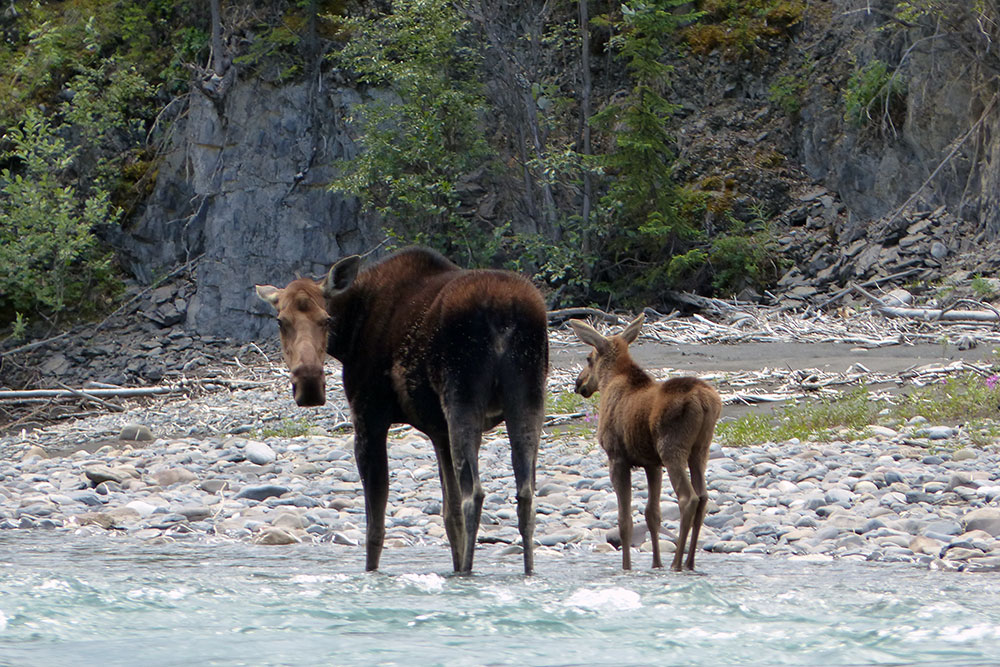Pı̨́ı̨́p’enéh łéetǫ́ǫ́ Deé (the Broken Skull River) is a unique and remote tributary of the renowned South Nahanni River in Canada’s Northwest Territories, located in Nááts’įhch’oh National Park Reserve and Nahanni National Park.
Emerging in the Selwyn Mountains, the Broken Skull flows through the valleys and gorges of the Mackenzie Mountains to then widen and braid before joining the South Nahanni River.
With endless trains of whitewater, steaming hot springs, breathtaking alpine vistas and boundless hiking opportunities, the Broken Skull is known for attracting the most adventurous paddlers from across Canada and the world.
Travelled by only a handful of people each year, this UNESCO World Heritage watershed and its captivating landscapes give you an intoxicating sense of remote isolation that will send you home with no end of stories to tell.
A Whitewater Canoeist’s Paradise
Imagine corner after corner of fun, friendly whitewater set against the backdrop of rugged mountain landscapes and untamed boreal forests.
Experienced paddlers will enjoy extended trains of rapids, tight corners and exhilarating canyon runs. Canoeists should be comfortable with paddling up to Class III with a loaded canoe.
World Class Hiking
The alpine terrain above the river is perfect for active adventurers. With easy access from the river, hikers are rewarded with breathtaking montane scenery, talus slopes and sweeping valleys. Few can resist donning their hiking shoes and exploring what lies beyond the river!
Both our 12 Day and 23 Day itineraries have time dedicated for hiking, allowing you to discover the secrets held by these landscapes for yourself.
Land, Language & Culture
The Broken Skull lies within the Sahtu land settlement area. An intimate, timeless connection exists between the land and cultures of the Sahtu Dene and Metis peoples who have inhabited the area for generations.
Whilst it is easy to be enamoured by the visual beauty of the landscapes, paddlers should be reminded that the region is not just a tourist destination; it has been and still is a place of harvest and sacred ritual for many.
Visitors are encouraged to read the Nááts’įhch’oh National Park Reserve Place Names and Pronunciation Guide, compiled in collaboration between Shúhtaot’ine Dene Elders and Parks Canada staff, to show respect and help keep language and culture as an integral part of the land.
Land, language and culture have been intimately linked since time immemorial.
Diverse Flora & Fauna: A Northern Costa Rica
The Broken Skull and Nahanni watersheds boast some of the most biodiverse regions of North America, making them the perfect destination for nature enthusiasts.
The lush boreal forests are dominated by white and black spruce, whilst a rich variety of wildflowers such as lupins, lady’s slippers and rare orchids create colourful mosaics in the alpine meadows above the river. You can read owner and outfitter Dana Hibbard’s guide to wildflowers of the Nahanni watershed here.
This breathtaking diversity is largely a result of the diverse ecosystems and habitats supported by the river, including thermal springs, waterfall mist zones, unglaciated terrain and permafrost areas.
An active wildlife corridor, the watershed provides excellent wildlife watching opportunities. Iconic northern species including moose, woodland caribou, wolves, lynx, grizzly and black bears frequent the Broken Skull River Valley, as do porcupine, beaver and a number of smaller rodents. 170 species of birds have been recorded in Nahanni National Park, including trumpeter swans, bald eagles, golden eagles, peregrine and gyrfalcons!
Read our Top 10 Tips for spotting more wildlife.
These pristine northern waters team with aquatic life too. For those keen on wilderness fishing, Divide Lake and the Broken Skull offer fantastic opportunities to catch species including Dolly Varden, lake trout and grayling.
See here for our guide to fishing on our river expeditions, including equipment to bring and what to expect.
Paddling offers unique opportunities for intimate wildlife encounters.
An Immersive Journey into Canada’s Backcountry
After a rendez-vous in Whitehorse, we take a scenic drive through the Yukon bush to the town of Mayo, where we load our gear onto a float plane and soar over the awe-inspiring Mackenzie Mountains.
Flying deep into the Nahanni watershed, a visually stunning panorama unfolds in front of our eyes, giving us greater perspective on the expansive wilderness we are about to travel through. (Be sure to have your camera at the ready!)
We land at Divide Lake, where the raw, untamed nature of the North fully reveals itself and sets the stage for your canoe journey of a lifetime!

The flight to Divide Lake crosses an immense, roadless wilderness.
A Closer Look at the Paddling Route
The first day of our canoe expeditions are spent at Divide Lake, where there is the chance to polish paddling skills before we hit the rapids. From the mouth of the lake paddlers can paddle and line their boats to the confluence with the creek. A short portage must be made around Swallow Falls, named for the cliff swallows nesting along the falls. Below the falls a small canyon can be paddled in certain water levels by skilled paddlers or lined in low water.
From where this creek joins the Broken Skull river, approximately 125 kilometers of beautiful, emerald water and incredible alpine views lie ahead. The river swells in size as several tributaries and creeks join, but it maintains its intimate feel until joining the much larger South Nahanni river.
Paddlers can opt for our classic 12 day expedition, or continue downstream on our 23 day expedition, allowing you to experience the wonders that the Nahanni River has to offer!

Pristine waters teaming with Dolly Varden, grayling and trout make the river as alluring as the alpine skyline!
Weather on the Broken Skull River
Located in a semi arid-region, paddlers must be prepared for a wide range of weather conditions. Weather can change quickly in mountainous areas; it is not unusual to have hot sunshine and heavy rainfall in the same day. Weather typically improves as groups descend from the mountains into the wider South Nahanni river valley.
Summer weather can be hot and dry although (on the rare occasion) it could snow, especially near the end of August. While inclement weather is a possibility at anytime, the weather is usually moderate. The average July temperature is 16°C and during August is 14°C, although temperatures of up to 30°C degrees are not uncommon. Summer precipitation is mainly convective in nature, occurring mainly in the afternoons or evenings in the form of showers or thunderstorms.
Our Details & Packing List contains a comprehensive list of what to bring. Our Expedition Planning Team are also always happy to answer any questions you might have!


Want to learn more? View our canoe trips on the Broken Skull River.











